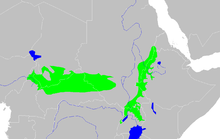Large Sudan landscape
The great Sudan landscape ( Arabic بلاد السودان Bilād as-Sūdān 'countries of the blacks') is located in north Africa south of the Sahara . It reaches as far as the tropical rainforest zone of the Guinea coast and the Congo basin. The cultural geographic area extends from the Atlantic coast of North Africa over a distance of around 5500 kilometers to the Ethiopian highlands in the east. The transition between the dry zone and the rainforest with the savannah vegetation is characteristic. The northern strip of the Sudan region is formed by the transition zone between the arid desert and the savannah and is knownas the Sahel zone in terms of climatic geography .
structure
The mostly hilly landscape of Sudan is divided into three basins by mountain ranges:
- in the west the Western Saharan Basin, which is drained by the upper reaches of the Niger and Senegal ,
- in the middle the outflowless Chad Basin with the Logone
- and to the east the basin of the White Nile .
history
In the western part of the greater Sudan landscape, states ( Songhai , from around the 4th century) and powerful kingdoms ( Mandinka ), which reached their greatest heyday in the 16th century , developed very early . In the middle area were the Hausa states ( Gobir , Katsina , Daura , Kano ), as well as Bornu and Kanem . Darfur joined in the eastern area and enabled trade contacts with Nubia and Egypt via Sannar .
Several important Trans-Saharan routes led north. One led from Kanem (in the area of Lake Chad ) via Bilma and Murzuk to Tripoli . From the trading centers of the Haussa (Katsina, Zinder ) an important route ran northwards via Agadéz ; other routes connected the trading cities ( Gao , Timbuktu ) on the Niger knee with the Maghreb (Agadir).
The ethnologist Leo Frobenius was the first German to describe the Sudan as a cultural area ( Von der Herrlichkeit des Sudans , 1923). The architectural province of Western and Central Sudan is considered an independent style region .
See also
literature
- Ralph A. Austen: Sahara. Exchange of ideas and goods for a thousand years (= Wagenbach's pocket books 716). Translated from the English by Matthias Wolf. Klaus Wagenbach Verlag, Berlin 2012, ISBN 978-3-8031-2716-7 .
- Wittig, Hahn-Hadjali, König, Schmidt, Szarzynski, Thiombiano: Dynamics of flora and vegetation in the West African Sudan zone using the example of Burkina Faso . In: Reports of the Reinhold-Tüxen-Gesellschaft . No. 18 , 2006, p. 57-68 .
- Dorothee Gruner: The clay mosque on the Niger, documentation of a traditional building type . Franz Steiner Verlag, Stuttgart 1990, ISBN 3-515-05357-3
- Elke Grawert: Everyday life and social position of women in Western Sudan. In: Edith Laudowicz (ed.): Fatimas Töchter. Women in islam. PapyRossa, Cologne 1992 (= New Small Library. Volume 29), ISBN 3-89438-051-9 , pp. 106–127.
Individual evidence
- ^ Dorothee Gruner: The clay mosque on the Niger, documentation of a traditional building type . Franz Steiner Verlag, Stuttgart 1990, ISBN 3-515-05357-3 , p. 43 ff.


